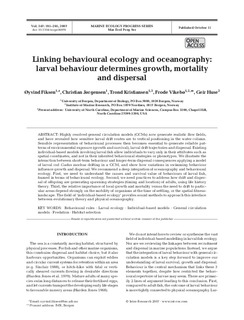| dc.contributor.author | Fiksen, Øyvind | |
| dc.contributor.author | Jørgensen, Christian | |
| dc.contributor.author | Kristiansen, Trond | |
| dc.contributor.author | Vikebø, Frode | |
| dc.contributor.author | Huse, Geir | |
| dc.date.accessioned | 2011-11-24T13:40:18Z | |
| dc.date.available | 2011-11-24T13:40:18Z | |
| dc.date.issued | 2007-10-11 | |
| dc.identifier.issn | 0171-8630 | |
| dc.identifier.issn | 1616-1599 | |
| dc.identifier.uri | http://hdl.handle.net/11250/108776 | |
| dc.description.abstract | Highly resolved general circulation models (GCMs) now generate realistic flow fields, and have revealed how sensitive larval drift routes are to vertical positioning in the water column. Sensible representation of behavioural processes then becomes essential to generate reliable patterns of environmental exposure (growth and survival), larval drift trajectories and dispersal. Existing individual-based models involving larval fish allow individuals to vary only in their attributes such as spatial coordinates, and not in their inherited behavioural strategies or phenotypes. We illustrate the interaction between short-term behaviour and longer-term dispersal consequences applying a model of larval cod Gadus morhua drifting in a GCM, and show how variations in swimming behaviour influence growth and dispersal. We recommend a deep integration of oceanography and behavioural ecology. First, we need to understand the causes and survival value of behaviours of larval fish, framed in terms of behavioural ecology. Second, we need practices to address how drift and dispersal of offspring are generating spawning strategies (timing and location) of adults, using life history theory. Third, the relative importance of local growth and mortality versus the need to drift to particular areas depend strongly on the mobility of organisms at the time of settling, or the spatial fitness-landscape. The field of ‘individual-based ecology’ provides sound methods to approach this interface between evolutionary theory and physical oceanography. | no_NO |
| dc.language.iso | eng | no_NO |
| dc.publisher | Inter-Research | no_NO |
| dc.subject | behavioral studies | no_NO |
| dc.subject | atferdsstudier | no_NO |
| dc.subject | habitat | no_NO |
| dc.title | Linking behavioural ecology and oceanography: larval behaviour determines growth, mortality and dispersal | no_NO |
| dc.type | Journal article | no_NO |
| dc.type | Peer reviewed | no_NO |
| dc.subject.nsi | VDP::Agriculture and fishery disciplines: 900::Fisheries science: 920::Fish health: 923 | no_NO |
| dc.subject.nsi | VDP::Agriculture and fishery disciplines: 900::Fisheries science: 920::Aquaculture: 922 | no_NO |
| dc.source.pagenumber | 195-205 | no_NO |
| dc.source.volume | 347 | no_NO |
| dc.source.journal | Marine Ecology Progress Series | no_NO |
| dc.identifier.doi | http://dx.doi.org/10.3354/meps06978 | |
